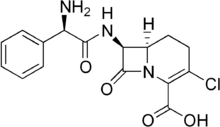Loracarbef
 | |
|---|---|
| Systematic (IUPAC) name | |
| (6R,7S)-7-[[(2S)-2-amino-2-phenylacetyl]amino]-3-chloro-8-oxo-1-azabicyclo[4.2.0]oct-2-ene-2-carboxylic acid | |
| Clinical data | |
| Trade names | Lorabid |
| AHFS/Drugs.com | monograph |
| MedlinePlus | a601206 |
| Legal status | ? |
| Pharmacokinetic data | |
| Protein binding | 25% |
| Identifiers | |
| CAS number | 76470-66-1 |
| ATC code | J01DC08 |
| PubChem | CID 5284584 |
| DrugBank | DB00447 |
| ChemSpider | 4447634 |
| UNII | W72I5ZT78Z |
| KEGG | D08143 |
| ChEMBL | CHEMBL1013 |
| Chemical data | |
| Formula | C16H16ClN3O4 |
| Mol. mass | 349.769 g/mol |
| SMILES
| |
| |
| | |
Loracarbef is an antibiotic.[1] Its use was discontinued in 2006.[citation needed] It is a carbacephem, but it is sometimes grouped together with the second-generation cephalosporin antibiotics. It was marketed under the trade name Lorabid. Loracarbef is a synthetic "carba" analogue of cefaclor, and is more stable chemically. Diarrhea is the most common adverse effect with Loracarbef. Side effects are more frequently seen with children under the age of twelve. It received FDA approval in 1991.
References
- ↑ Biedenbach DJ, Jones RN (February 1994). "Predictive accuracy of disk diffusion test for Proteus vulgaris and Providencia species against five newer orally administered cephalosporins, cefdinir, cefetamet, cefprozil, cefuroxime, and loracarbef". J. Clin. Microbiol. 32 (2): 559–62. PMC 263078. PMID 8150976.
External links
| ||||||||||||||||||||||||||||||||||||||||||||||||||||||||||||||||||||||